Say, “Cheese!”
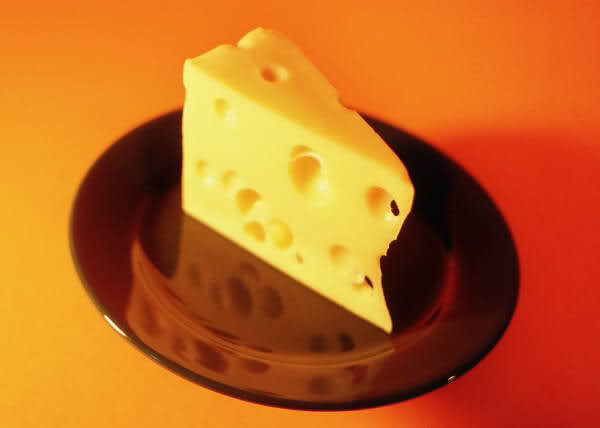
I’ve always heard that “necessity is the mother of invention” but I also think that it is “the mother of learning something new”. Such was the case recently after a productive trip to our local grocery which is owned and operated by the Absentee-Shawnee Indian Tribe. On this particular day I discovered that the store had block cheese on sale; 1 8oz block for $1. Never one to pass up a good deal, I decided that if one block of cheddar was good, 20 blocks of a variety of cheese was phenomenal! I tossed mild cheddar, mozzarella, sharp cheddar, pepper jack and cojack into my cart and trotted on down the isle. To my surprise, I found that Velveeta was on sale too. Oh joy.
Now, I must digress here for a sec in defense of Velveeta cheese PRODUCT. Although I realize that Velveeta is the plasticized version of cheese, it is a must for any kitchen simply because it melts sooooo smoothly. It is wonderful for cream soups. It is true that nobody REALLY knows where Velveeta comes from. And while we are told that it is made from milk, it could be guinea pig milk for all we know. However, while we ponder how one milks a guinea pig, the rest of America is enjoying its queso made with Velveeta, picante sauce and maybe some ground beef flavored with taco seasoning. Velveeta is to the cheese world what Spam is to the ham world. Each has its purpose.
And so, I got my Velveeta and checked out. On my way home, it occurred to me that all of this cheese had to have a place to go to stay fresh. I usually grate my hard cheese, put it into bags that I can vacuum on my FoodSaver sealer and then freeze it, but this was going to be an enormous amount of grated cheese. What if I wanted sliced cheese? My experience with freezing blocks of cheese for slicing had been less than successful. I had been totally unhappy with frozen Velveeta, so what to do? What to do?
Thank goodness for the Internet. Enola Gay at Paratus Familia had the solution. Can it! Can cheese? Really? She showed how to can hard cheeses and that got me to thinking about canning the Velveeta too. I researched and researched and found several ways to do that as well. I wound up with what I think worked best for me. So first, I’ll show you how I canned the hard cheeses and then the Velveeta. Talk about handy. You can’t believe how wonderful it is to have canned cheeses. You can shred and slice the hard cheese and the Velveeta is just as good as if it were in the box. I suppose at this point I should throw in the disclaimer that I haven’t found anything that indicates the government watchdogs have given their seal of approval to this, but then, they don’t like us canning apple pie filling either. From everything I have read, these canned cheeses last up to two years.
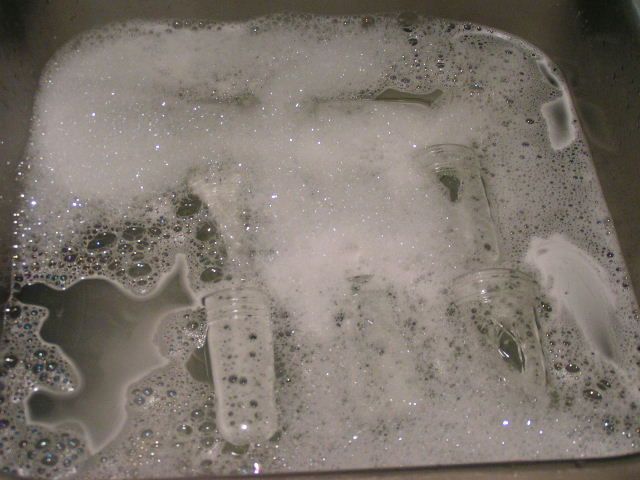 It is important that you sterilize your jars. Here, I am using the 8 oz size because there are just two of us and that is perfect for two people. First I wash them in hot, soapy water and then place in a large pot to bring to a boil. Then I remove them to place upside down on a dry towel. It is important to use wide mouthed jars for easy removal of the cheese.
It is important that you sterilize your jars. Here, I am using the 8 oz size because there are just two of us and that is perfect for two people. First I wash them in hot, soapy water and then place in a large pot to bring to a boil. Then I remove them to place upside down on a dry towel. It is important to use wide mouthed jars for easy removal of the cheese.
Canning Hard Cheeses
 Shred the cheeses. You can use a food processor here, but by hand isn’t all that more time consuming.
Shred the cheeses. You can use a food processor here, but by hand isn’t all that more time consuming.
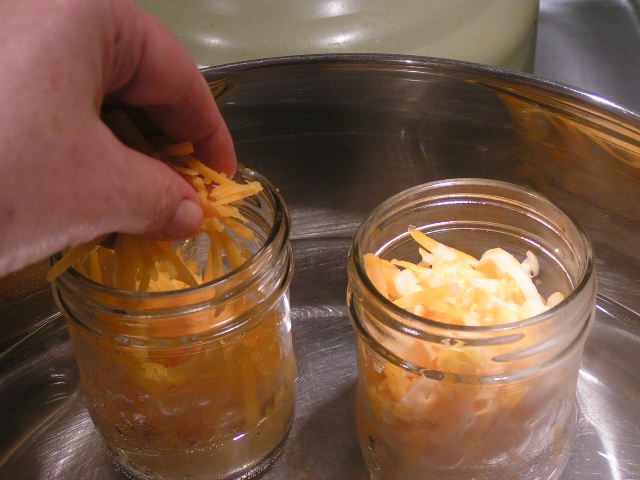 Place some of the shredded cheese into the warm jars and place the jars in warm water that you slowly bring to good and hot. Keep adding more cheese as the cheese melts.
Place some of the shredded cheese into the warm jars and place the jars in warm water that you slowly bring to good and hot. Keep adding more cheese as the cheese melts.
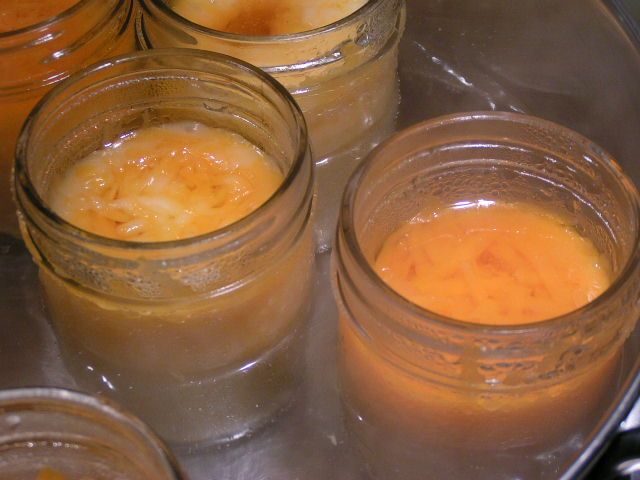 Continue adding and melting the cheese until it reaches a 1” headspace. This requires a deeper headspace because of the oils.
Continue adding and melting the cheese until it reaches a 1” headspace. This requires a deeper headspace because of the oils.
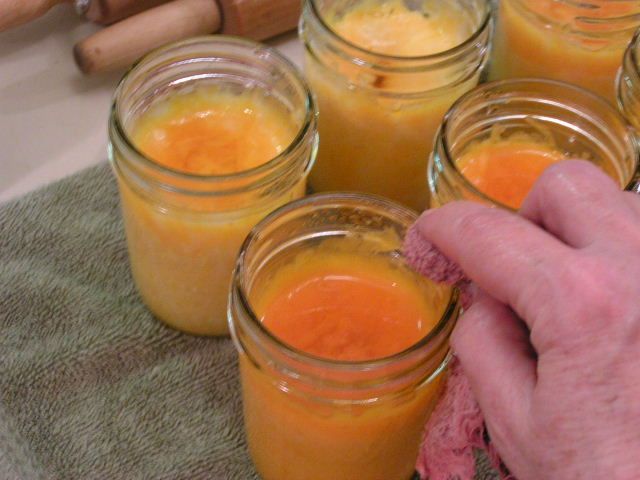 Carefully wipe the tops of the jars with a damp, soaped washcloth to remove all oils.
Carefully wipe the tops of the jars with a damp, soaped washcloth to remove all oils.
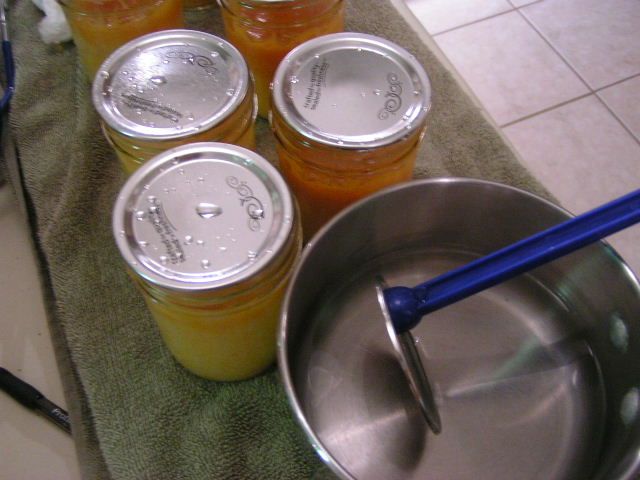 Place lids that have been warmed in nearly boiling water, onto the jars
Place lids that have been warmed in nearly boiling water, onto the jars
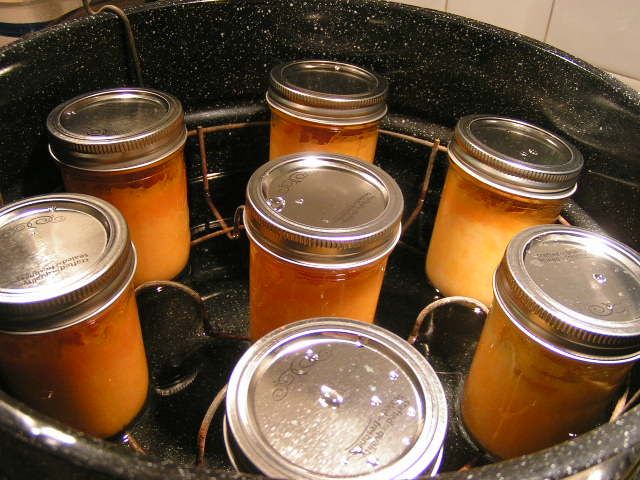 Put the rings onto the jars, not too tight and place into the rack of a waterbath canner
Put the rings onto the jars, not too tight and place into the rack of a waterbath canner
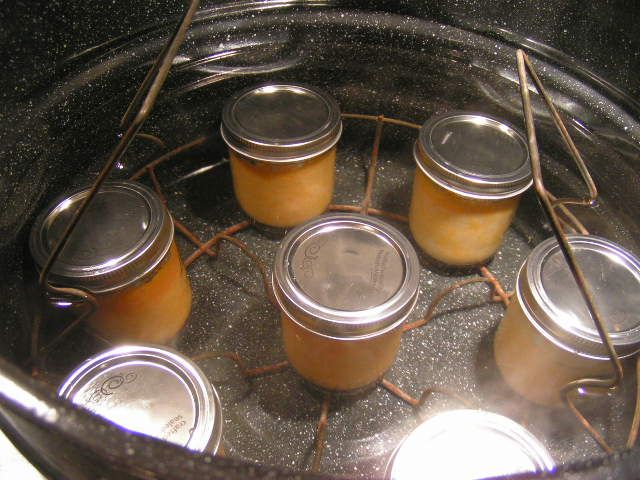 Lower the jars into water that has already been heated. Putting them into cool water will crack the jars. Bring to a boil and at the point of boiling, set your timer for 40 minutes. Process for 40 minutes.
Lower the jars into water that has already been heated. Putting them into cool water will crack the jars. Bring to a boil and at the point of boiling, set your timer for 40 minutes. Process for 40 minutes.
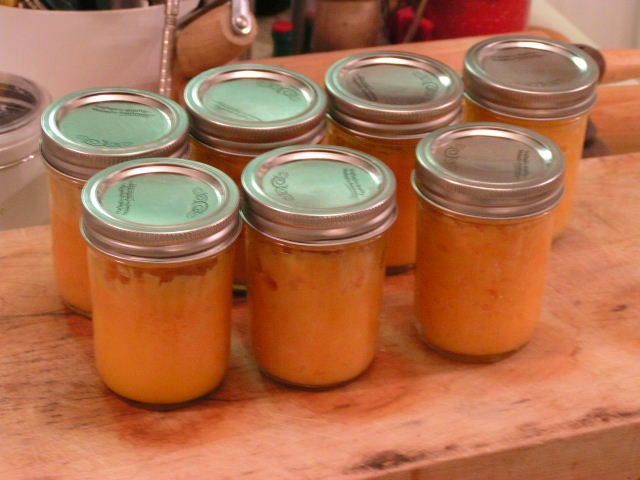 Now here is the important part!! I didn’t figure this out until I pulled the first jar out of the water. DO NOT REMOVE THE JARS FROM THE WATER UNTIL THEY HAVE COOLED DOWN. If you take them out of the boiling water, the oil from the cheese boils out of the jars and they won’t seal. Just leave the jars of cheese under water and allow to cool slowly. THEN take them out of the water. When they have cooled all the way down, I remove the rings and wash jars and rings in hot, soapy water to remove any oils. After drying, I reapply the rings and store the jars of cheese.
Now here is the important part!! I didn’t figure this out until I pulled the first jar out of the water. DO NOT REMOVE THE JARS FROM THE WATER UNTIL THEY HAVE COOLED DOWN. If you take them out of the boiling water, the oil from the cheese boils out of the jars and they won’t seal. Just leave the jars of cheese under water and allow to cool slowly. THEN take them out of the water. When they have cooled all the way down, I remove the rings and wash jars and rings in hot, soapy water to remove any oils. After drying, I reapply the rings and store the jars of cheese.
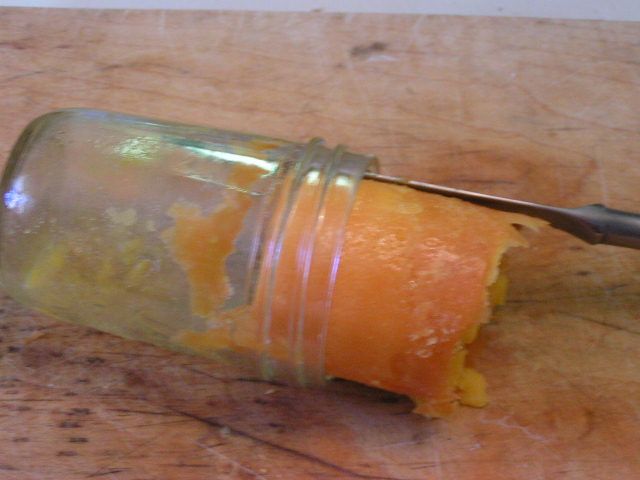
To remove the cheese, open the jar and slide a knife inside the jar and around the cheese. The cheese will just slide out. You can then grate it. At first it is a little oily, but that is just because it is at room temp and some of the oils have separated.
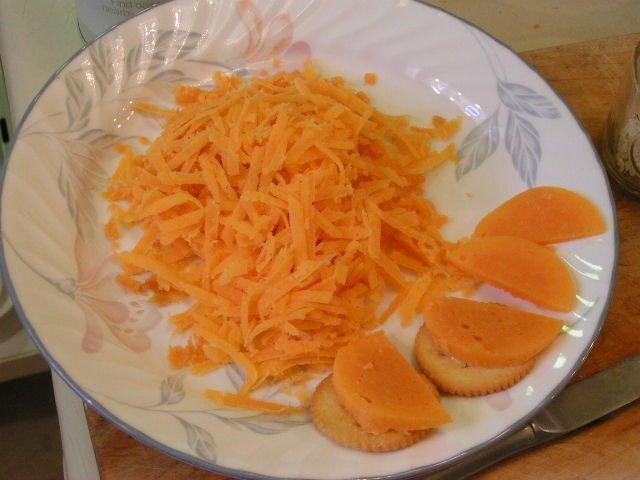 Or slice it! It’s perfect for crackers and cheese.
Or slice it! It’s perfect for crackers and cheese.
Canning Soft Velveeta or Soft Cheese
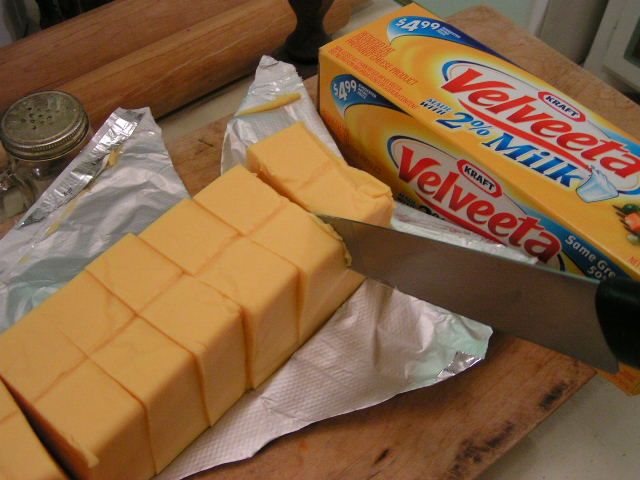 Cube a box of Velveeta
Cube a box of Velveeta
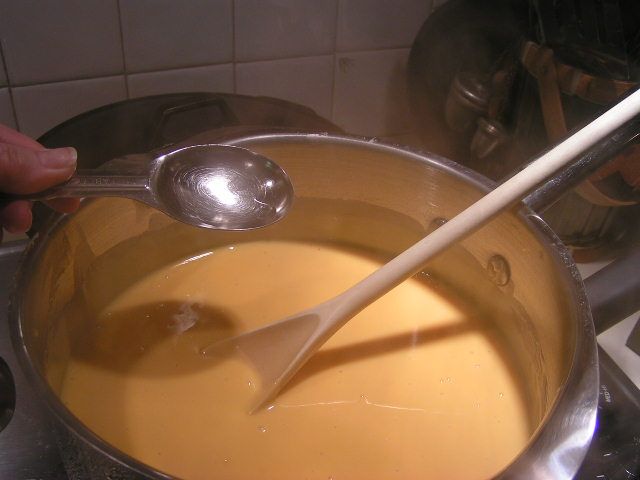
Place in a double boiler with 3 oz canned milk and slowly melt. When melted, add 1 tablespoon of vinegar and stir in
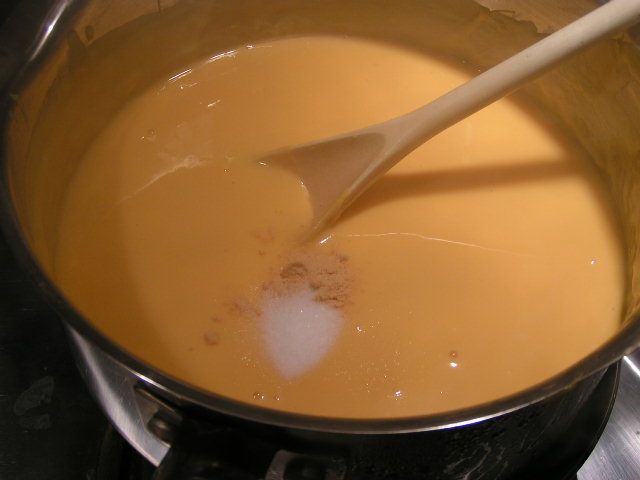 Add 1/2 teaspoon of dry mustard and 1/2 tsp salt and stir well until totally smooth and melted
Add 1/2 teaspoon of dry mustard and 1/2 tsp salt and stir well until totally smooth and melted
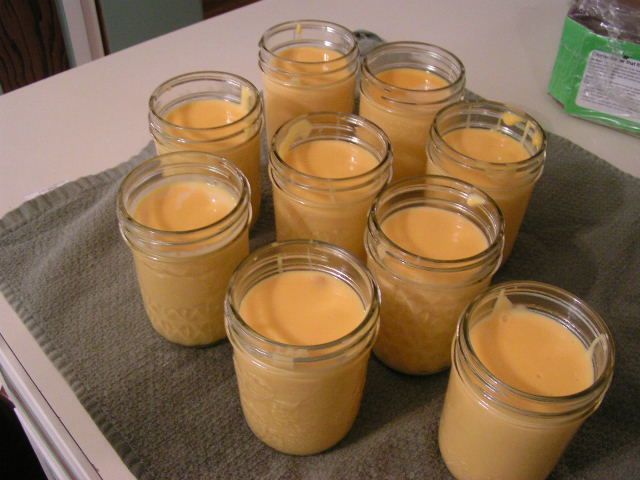 Pour the cheese into jars leaving a 1/2 inch headspace. I use 8 oz jars. I can always open two 8oz jars if I need a pint.
Pour the cheese into jars leaving a 1/2 inch headspace. I use 8 oz jars. I can always open two 8oz jars if I need a pint.
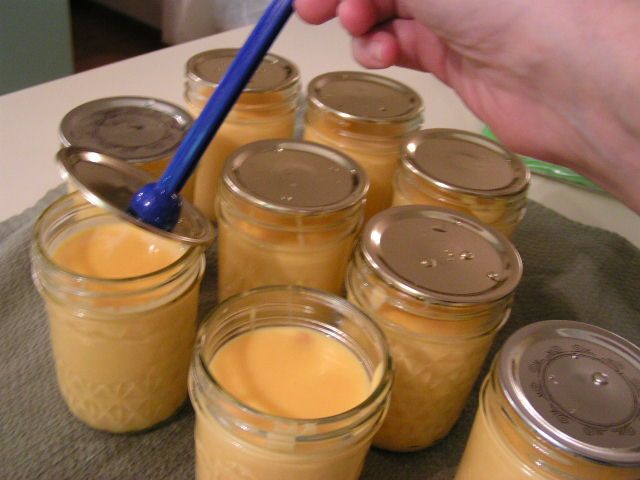 Carefully wipe the rims of the jars to remove any wayward cheese and place lids that have been heated in nearly boiling water on top of jars
Carefully wipe the rims of the jars to remove any wayward cheese and place lids that have been heated in nearly boiling water on top of jars
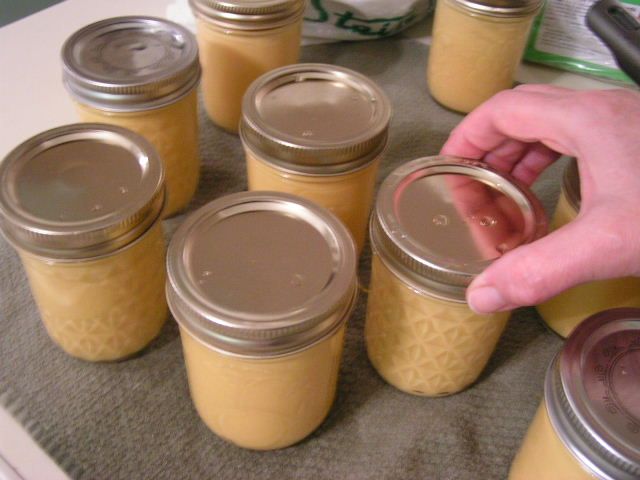
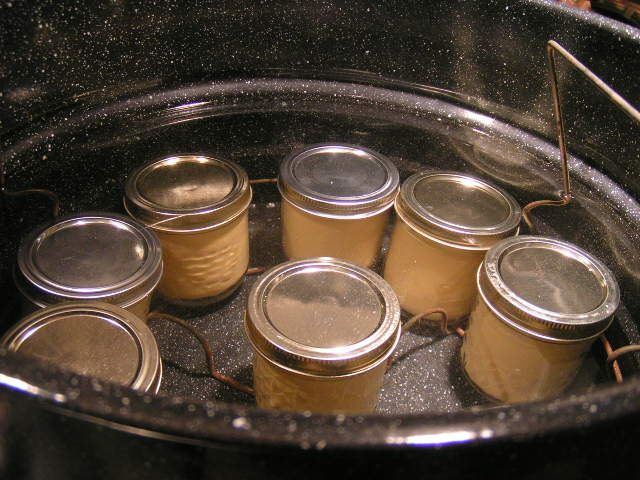
Put rings onto the jars and tighten down slightly. Place jars in waterbath canner rack and lower into water that has already been heated so not to crack the hot jars of cheese. Bring the water to a boil and at the point of boiling, set your timer for 10 minutes and continue to boil.
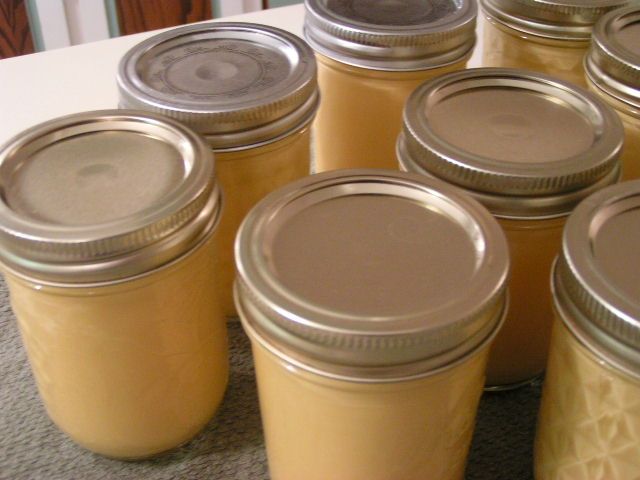 Remove jars from water and allow to cool on a dry towel. You will hear the lids pop as they seal.
Remove jars from water and allow to cool on a dry towel. You will hear the lids pop as they seal.
And so, I’ve learned something new out of necessity. I LOVE having cheese in the can. It is so easy and I don’t have to worry about refrigeration. The cheddar gets a little sharper as it ages and tastes wonderful when opened. So cut the cheese and call me “Happy”!!
Happy Cooking!
MB
Please leave your comments at the comment link that follows!
|
Tags: canning, cheese, Cojack, education, preparedness, Sharp, Velveeta, vinegar, waterbath
This entry was posted
on Wednesday, February 9th, 2011 at 2:40 pm and is filed under Canning and Food Processing, So You Have To Make It Educational!!.
You can follow any responses to this entry through the RSS 2.0 feed.
Responses are currently closed, but you can trackback from your own site.





















Have you ever canned cheese that you bought already shredded? Sometimes I find this actually cheaper than the block cheese. I wondered if it would can the same since it has some powder in it to prevent clumping. Thanks for the great post!
Aleah, I haven’t used the shredded cheese, but I am certain that it will work fine and simply will shave (no pun intended) one step off of the job! Shredded cheese came from block cheese, so I say, “Go for it!”
What a great idea – I have never canned anything but I would love to do this with cheese. I really want to try this. I just need a good deal on cheese.
It’s great! Saves so much refrigerator and freezer space! Let us know how successful you are. 🙂
This is fabulous! I didn’t know cheese could be canned. I’ll be keeping my eyes out for sales.
Shara, I’m loving my canned cheese!
I’ve read a lot of canning books, but I have never heard of such a thing! What a great idea!!! THank you so much for sharing.
JanelleS
http://www.financiallyfree4ever.blogspot.com
I know Janelle. I looked in books too, but ended up researching on the Internet. What did we ever do without it??
Shazam! I love the barn hop party! Yours is the THIRD blog where I learned something completely new!! I’m in the process of stocking my food inventory in preparation for emergencies. No one can survive a disaster on beans and rice alone. Canning cheese is such a great idea for preserving a dairy product – I never knew it was possible. Thanks for sharing!
I’ve seen Enola’s cheese canning post, and mentioned this process on my own site, but I’ve yet to try it myself. Thanks so much for the step-by-step tutorial!! We’ve been eating almost exclusively from our food storage for the past several weeks, and one thing we have severely been lacking is CHEESE!! And you need it for almost everything! The next time we have a little extra money, and I find a good deal on cheese, I am definitely stocking up and canning it. They say it’s not safe… but they also say raw milk and homebirthing aren’t safe too. I think I trust those who have been doing it for decades for their opinion on whether it’s safe or not, instead of a government agency 🙂
Thanks for linking up!
Oh, I have never knew one could can cheese! I buy cheese in bulk and freeze it but will definately be trying this out ! Thanks for sharing.
Thanks for reading, Jill!!
Thank you Kendra. I love Enola Gay’s site and Patrice’s too. If it’s ok, I’m going to put a link to your blog on my blog “Welcome” page.
Cary Ann (love your name) thanks for reading. Good luck with it! I’m a cheese-aholic and so we go through a lot of it.
This is wonderful. Thank you so much for this tutorial. I am new to your blog. came over from Homestead Revival Bar Hop. I will be coming back.
Blessings, Linda
Linda, so glad that it was helpful to you! And I’d love to have you back!! 🙂
Just because you can doesn’t mean you should.
“Meat, vegetables, butter, cream, etc. are low-acid products that will support the outgrowth of C. botulinum and toxin formation in a sealed jar at room temperature. Low-acid products have to be pressure-canned by tested processes to be kept in a sealed jar at room temperature.”
National Center for Home Food Preservation http://www.uga.edu/nchfp/
Actually, according to everything I read, cheese has a PH of 5.6 which is acidic and processed dairy products can have an even lower PH. One very popular product on the market, in stores today, is called “ghee” which is the Indian version of canned butter and it is waterbath canned. That is the subject of my post today. Ghee has been around for thousands of years.
I threw out 5 cases of food that werent processed long enough as everyone that I talked to about it said 40 minutes wasnt enough. I was using a pressure cooker/canner that didnt have instructions about time and didnt have a pressure gauge. Its a shame all my food went to waste, but better safe than sorry. The only way to know for sure if your cheese is safe is to send it to a lab to check for botulism. It is something that cannot be smelled, is impossible to detect without testing and is deadly. Have you thought about taking one of your older jars in somewhere to make sure its safe to eat? I’d love to can cheese, but am afraid to unless im 100% sure its not deadly 2 years down the road.
Cheese is acidic, but if you are worried, you can pressure can your cheese for 20 minutes at 10 lbs of pressure (like with milk) or you can add vinegar to your hard cheese before you can it. I did not make up this process, but have followed others more expert than I in their way of canning cheese.
Regarding your food that you threw out – if you had just pressure canned it, then you could have reprocessed at the right amount of time. If it had been sitting on the shelf, that’s a different story. If it had been waterbath canned, then 40 minutes was more than enough time – probably too much. Waterbath times are different from pressure canning times. One should never guess on times to process foods, but should consult a table for the particular processes before starting. And if your canner has a weight rather than a guage, the weight should be adjustable to different weights of 5, 10 and 15 lbs. If the weight is not adjustable, then you have a pressure cooker, not a pressure canner, and that is definitely dangerous to use as it can’t be calibrated.
I love canning cheese have been doing it for a few years. I also like making my own cheese whiz sauce and canning it. Love your instructions!! 🙂
It does come in handy, doesn’t it, Mary!!!
I have only been canning veggies and fruit for the past 5 yrs or so, and we’ve not died yet. I actually don’t always pay as close attention as I should to how long I water bath/boil my jars of food. I WILL pay closer attention. I know there are people out there worried about botulism, and I do worry sometimes too, but my mother-in-law is almost 80 and has been canning for years…she’s not lost a family member to botulism yet…I go to her with all my questions.
I freeze all of our cheese, but I usually just buy shredded…however, there are times that freezer space is an issue. I will be keeping this ‘recipe’ to use when needed…or maybe to just try sometime!! AWESOME!!!
I especially like the canned velveeta, Ginger. So awesome to have for soups and sauces and spreads!
The hard cheese directions does not have any vinager in it, yet it is only in a hot water bath instead of pressure canning it. Is that safe? There is no acid in it in other words.
Just read your answer above. Sounds good to me. Can’t wait to try it. 🙂 Thanks.
Great, Diane. If you want to add 1/4 tsp of vinegar to half pints and 1/2 to pints, you can do that. Oh, and you are entered!
when canning velveeta, you said to add canned milk, is that condensed milk or evaporated milk?
Hi Tami. That’s evaporated milk, not sweetened, condensed milk.
It took me a long time to work up to pressure canning, I would be really scared to do this without a pressure canner. You say that cheese is acidic, but I doubt it is all the same ph. The same goes for some of the butter posts, they weren’t even sealed with a water bath. Kind of scary, would love to try this.
Pressure canning would make an oily mess of cheese. And if you read the entire post on the butter, it is definitely waterbath canned. The Indians have been canning Ghee for centuries, which is a clarified butter. However, never try anything with which you are not comfortable.
If hard cheese is pressure canned and if one felt uneasy about eating it could the cheese from 1 jar be put in pan and heated slowly on stove. Would this not kill botulism. The food preservation always say to boil food that has been home canned for 5-10 min. to be on safe side. Can’t boil cheese but looks like if it’s heated in such a way simmer in pan or double boiler till really hot(just thinking worse case senario-economic collapse) that this would work. Like to hear other thoughts on this.
Brenda, hard cheese is not pressure canned. It is waterbath canned. And if anyone was uncertain, they could use the cheese only for baked or other cooked products like baked macaroni and cheese, enchiladas, etc. People forget that cheese is milk that has been aged with bacteria. That is what makes it cheese!!
Is the 3 oz. can of milk for soft cheese based on a one or two pound box of cheese, and are you useing vinegar that cones in gallon jugs?
I can’t wait to try this.
Sharon, that’s a 2 lb box of cheese and the vinegar is just plain 5% white vinegar. Yes, it comes in a jug. And since you posted, you are entered in our Fall Giveaway! Thanks.
[…] item to can, so be educated. Broth – Chicken Broth – Beef Broth – Vegetable Cheese Ketchup 1 Ketchup 2 Ketchup 3 Mushrooms Pickles – Dill Pickles – Bread and Butter […]
[…] The Oklahoma Pastry Cloth and let Mary Beth show you how to can butter, cheese and probably anything else you can think of. […]
[…] item to can, so be educated. Broth – Chicken Broth – Beef Broth – Vegetable Cheese Ketchup Mushrooms Pickles – Dill Pickles – Bread and Butter Pickles – Kosher […]
[…] Buttermilk 1 cup shredded Monterey jack cheese 1 cup shredded Cheddar Cheese (you can use your canned cheddar) 2 slices American Cheese (You can use your canned Velveeta) 1 small onion chopped 2 tbsp. chopped […]
Reader, Mary Hines, sent the following comment:
Just read your blog on canning cheese and the responses of people worried about botulism. it should be noted that botulism can be destroyed with heat. I personally dont worry with it. It’s a dirt borne organism and commercial cheeses have been commercially pasteurized. There is no botulism in it, unless you don’t sterilize your jars first. (Who doesn’t sterilize jars for water bath canning?). Thank you for posting how to can cheese…and for the negative responses you got, just tell them if you’re worried about botulism, just use it for cooking, boil it for 20 minutes, botulism dies. 🙂